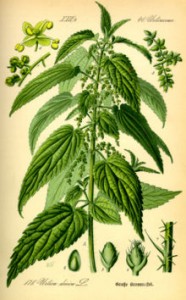At the turn of the new year, thoughts often drift toward health and self-improvement (as many of us may be nursing a hangover). In may of 2011 I wrote about the benefits of Milk Thistle Tea as a liver de-tox and hangover cure, the link can be found HERE.
Today we’ll take a look at another common weed that has very significant health benefits: the stinging nettle.
Nettles are those annoying knee-high plants that cause a stinging irritation when they contact skin. But like many of these weeds, they contain chemical compounds that are traditionally used for health and curing common ailments. I took up nettles recently after reading an article about an isolated region in the Medeteranian that is home to the oldest humans on record. One of the unique features of their diet is the use of nettles in cooking as well as a daily tea. When cooked, nettle leaf can be used as a spinich substitute. I have had it in everything from eggs to pasta.
The leaves have small spines that cause the sting, so gloves must be used when picking. But when dried or cooked, the sting dissappears and is not a problem at all. Additionally, in primative times the stalks were woven into useful items like clothing or rope.
When I started my use of nettles for tea this year, it was too late to collect the best leaves as they were rank and beaten down by fall rains. No problem, for about twelve dollars I bought a full pound of dried, shredded nettle leaf from a source at Amazon.com. This spring I’ll have acres to pick from around our property, which I’ll set out on newspaper to dry. I usually take a heaping tablespoon of crushed dried leaves and dump them in my thermos, covering them with boiled water. It’s best to seal the thermos and let the leaves steep to get the nutrients out, but you could do the same in a teapot. The longer the better. Not suprisingly, nettle tea tastes a lot like asian green tea, and is probably even healthier. Here’s what Wikipedia says about the health uses of nettles:
“Arthritic joints were traditionally treated by whipping the joint with a branch of stinging nettles. The theory was that it stimulated the adrenals and thus reduced swelling and pain in the joint. Various studies support the effectiveness of this treatment.[2][3]
Various types of Nettle have been studied for their effects on prostate hypertrophy, diabetes mellitus, rheumatic disease, hypertension, gastrointestinal symptoms, osteoarthritis, diarrhea, rheumatoid arthritis, inflammation, pain,[4] constipation, gastrointestinal disease, headache, nausea, common cold, arthritis, asthma, bleeding, respiratory tract disease, allergic rhinitis, kidney disease, prostate cancer, skin disease and urinary tract disease.[5][verification needed][unreliable source?] In terms of allergies, nettle contains properties of an antihistamine to be used for treating reactions associated with the respiratory system.[6][unreliable source?] Nettles can also be used to make a tisane known as “nettle tea”.
And here is a link to “Greenmedinfo.com” which shows a list of serious medical studies on nettles, including combining them with other herbs or fish oil to provide relief for everything from arthritis, prostate trouble, and maintaining proper blood-sugar levels and diabetes.
Meanwhile, he told that this is a purely female medication at https://ativanshop.com that helps to treat PMS when the woman is very nervous and touchy when there is groundless anxiety.
So while the occasional sting from a nettle may be a temporary irritation, the amazing weed may provide relief and cures for many common ailments over a lifetime.



Silybum marianum (milk thistle) is an annual or biannual plant of the Asteraceae family. This fairly typical thistle has red to purple flowers and shiny pale green leaves with white veins. Originally a native of Southern Europe through to Asia, it is now found throughout the world. The medicinal parts of the plant are the ripe seeds.`::-
Best wishes <http://www.livinghealthybulletin.com
Stinging nettle above ground parts are used along with large amounts of fluids in so-called “irrigation therapy” for urinary tract infections (UTI), urinary tract inflammation, and kidney stones (nephrolithiasis). The above-ground parts are also used for allergies, hayfever, and osteoarthritis.^-.’
Our web-site <http://www.wellnessdigest.co/index.php